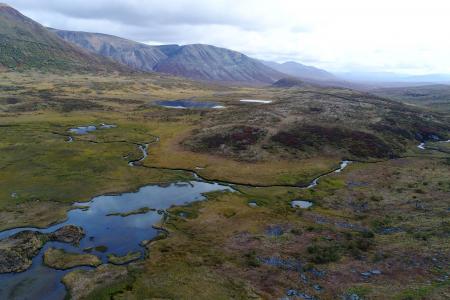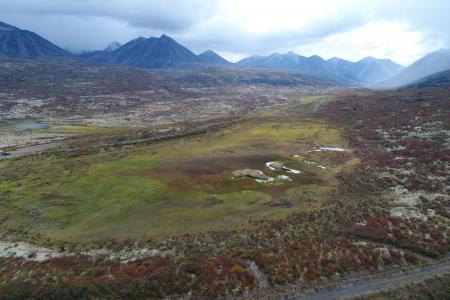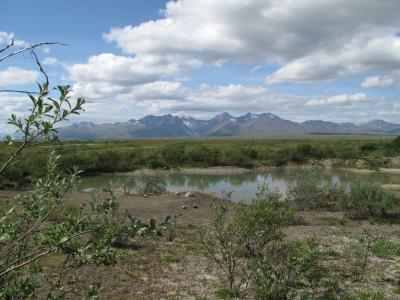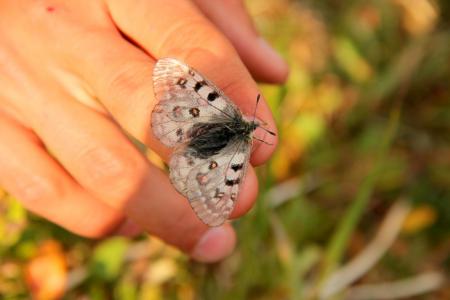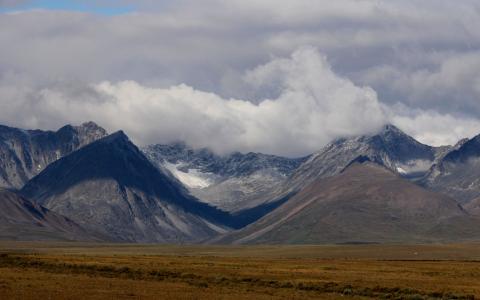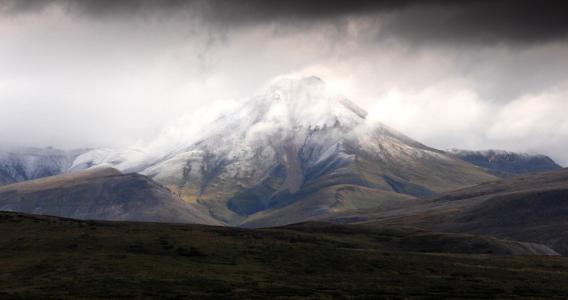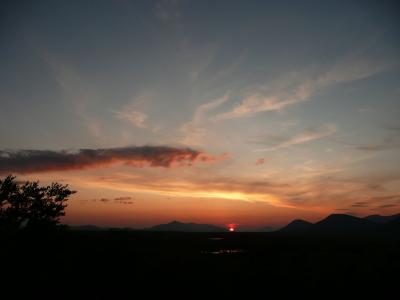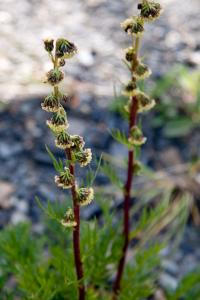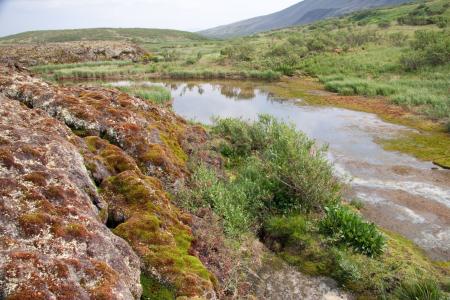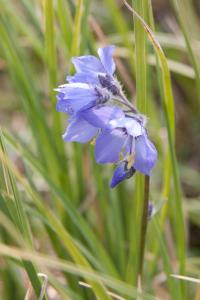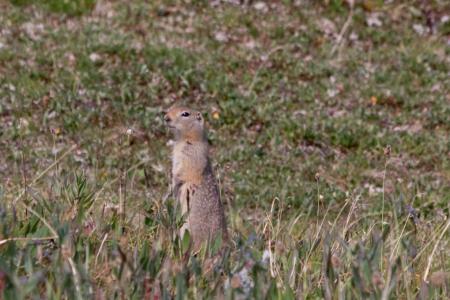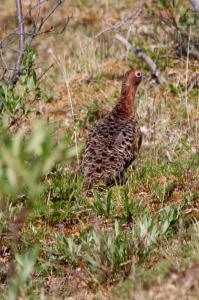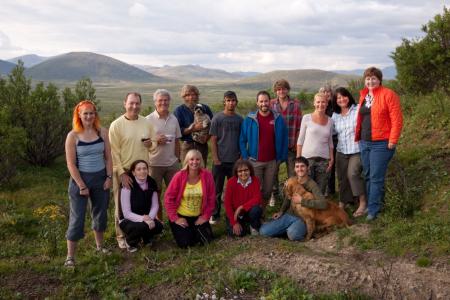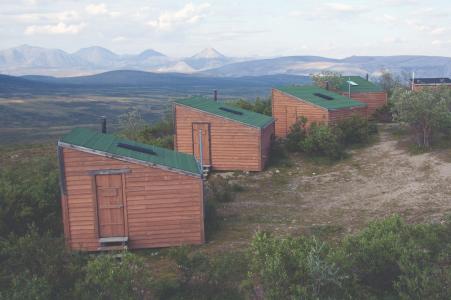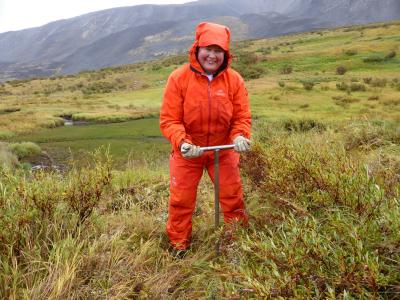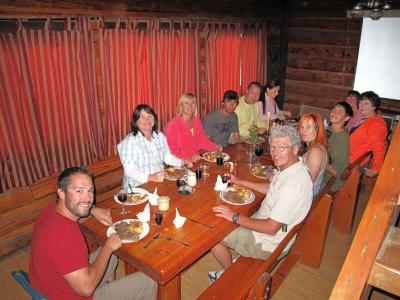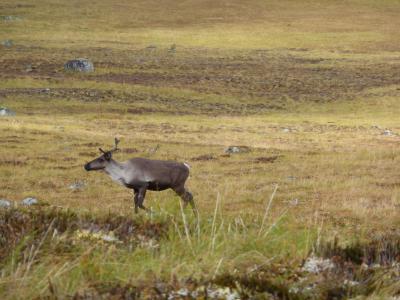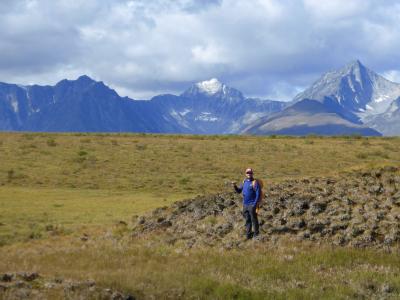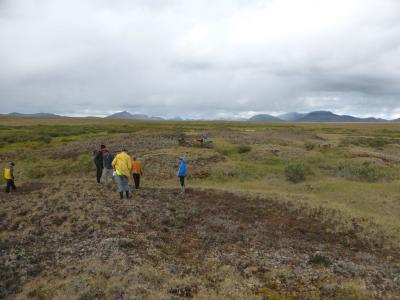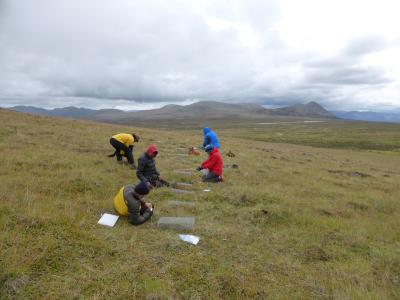.
Please read the following information before leaving for your expedition.
It provides the most accurate information available and will likely answer any questions you have about the project. You may also reach out to your Program Coordinator with any questions you may have.
Click on the images to view full size!
COVID-19 Safety
Please test for COVID-19 before traveling to your expedition; do not travel if you have tested positive, and call Earthwatch right away for the next steps. Visit earthwatch.org/covid-19 for more information on how you can help reduce the risk of COVID-19 impacting your expedition.
The Research
At the Arctic’s edge we can measure the evidence of global warming. As a result of recent warming, polar sea ice is shrinking, glaciers are retreating, the winter snowpack is becoming less extensive and is melting earlier, and permafrost is degrading (ACIA, 2004; IPCC, 2023). Biological evidence of warming is also mounting. For example, growth of trees at the treeline (beyond which trees do not grow) has been enhanced, plant community types are shifting, and northern ecosystem characteristics are changing (Chapin III et al., 2005, Harsch et al., 2009, Morison et al., 2023). Residents of northern regions rely on these ecosystems, and consequently they are also being affected. Over the next few decades, the effects of global warming are expected to be greatest at high latitudes. Estimates of the amount of warming go as high as 6°C in the mean annual temperature, and at Churchill on Hudson Bay in Canada there has been a warming of approximately 2°C in annual air temperatures since record keeping began in the 1880s.
Permafrost (where the ground temperature remains below 0°C for more than a year) underlies 24% of the surface of the Earth, including vast areas of Russia, Canada, China, and Alaska. An estimated 50% of the world’s terrestrial carbon stores are locked up in permafrost (Tarnocai et al., 2009, Olefeldt et al., 2016, Lindgren et al., 2018). Northern circumpolar peatlands, mineral soils, and deltas have 1,672 gigatonnes of organic carbon and >67 gigatonnes of nitrogen (Voigt et al., 2017), and 88% of this area is affected by permafrost. Permafrost in the northern hemisphere is warming (Biskaborn et al. 2019), and the zone of permafrost is predicted to shift northward. As the permafrost thaws, its vast stores of organic matter begin to decompose, producing carbon dioxide, methane, and nitrous oxide—three strong greenhouse gases. The release of these greenhouse gases into the atmosphere will amplify the current warming effect in a positive feedback loop (Voigt et al., 2017 and Crowther et al., 2017).
Climate Change in the Mackenzie Mountains
Research Aims
Our main research goal has been to establish an environmental monitoring program to collect baseline quantitative data on climate-related changes in northern ecosystems. Earthwatch participants make it possible to obtain large numbers of samples over a short period and are vital to the success of the monitoring program.
The Mackenzie Mountains research sites have been under study since the 1970s, with year-round monitoring beginning in 1990. Over the period of record keeping, it is apparent that interannual variations can be great. Long-term studies of these highly variable systems are the most valid approach, enabling researchers to place short-term ecosystem-modifying events into their proper context.
The more than 30-year record from the Mackenzie Mountains confirms an increase of approximately 1.3°C in mean annual permafrost temperature. This coincides with an increase in treeline tree growth. The treeline is a zone of ecological stress where minor changes in the environment can have significant ecological impacts. For example, warmer growing seasons can lead to a greater number of viable tree seeds produced and higher germination success, thus allowing the treeline to migrate further into the tundra—but only if seeds aren't competing with surrounding vegetation and/or being eaten by animals.
Only long-term studies have the time frame to capture these unpredictable events. With each additional year of data comes a greater understanding of these systems and how they function. This study can provide evidence of these early-warning signs of global environmental change driven by climate change.
Climate Change in the Mackenzie Mountains
How You Will Help
You will assist in both field and lab research. The amount of time you will spend at each site will vary, but you should expect to spend about 60% of your time at the research sites and the remainder working indoors. Most of the sites require 30 minutes to three hours of travel time in a four-wheel-drive vehicle, though some are within walking distance from camp. You may help set up and monitor equipment and collect data on features of the permafrost and soil; the occurrence of vascular plants, lichens, and mosses; plant phenology (the timing of seasonal events such as flowering, first leaves, etc.); annual growth rings of trees; seed germination success in the field; and the numbers of mammals and birds. You will be taught methods of identifying animals and plants, although some identification experience would be helpful. The equipment you will be operating will be relatively easy to use, including a dissecting microscope, frost probe, permafrost corer, tree borer, plant press, and GPS.
Climate Change in the Mackenzie Mountains
Life in the Field
You will be given lectures on general topics such as climate change, the evolution of permafrost landforms, plant community succession, and disturbance regimes. Talks and presentations on topics specifically related to the study area could include the formation and status of local permafrost landforms, the ecology of wildlife species, disturbance ecology, the significance of the project to the community, and climate change monitoring in general. Depending on the tasks that you will be performing, you will also be given practical talks on plant species identification, community structure, sampling techniques, and monitoring and census techniques. You will also learn about the concepts behind tree boring and dendrochronology (dating by analysis of the pattern of tree growth rings), and the use of various kinds of equipment.
Steven Mamet and his capable field staff participate in the fieldwork and provide theoretical and practical training for every component of the study. Questions are encouraged, and objectives and tasks are reviewed daily during briefings. Some basic knowledge of biology, geography, and ecology is helpful but not required. Computer skills would be beneficial, but training can be provided on word processor and spreadsheet programs. Most important is a strong interest in natural history. Individual tasks will be matched with the interests and skills of participants whenever possible.
ITINERARY
Weather and research needs can lead to changes in the daily schedule. We appreciate your cooperation and understanding.
- Day 1: You will board the charter flight in Whitehorse to take you to the research site. After your arrival, there will be an introduction and orientation with time for participants to recover from travel. A meeting will be conducted to outline the objectives and methods of the team and guidelines for safety, and to provide a preliminary schedule.
- Day 2: There will be demonstrations of equipment and training. If this is completed in the morning, the team will conduct measurements on a research site in the afternoon.
- Days 3–10: Each day will begin with a briefing to outline the day’s activities. At least half of each day will be spent at the research sites collecting data. Given the travel times involved to reach the sites, the team may picnic in the field. Depending on the tasks, there might be an evening trip to catch the sunset or other excursions. There will normally be an evening briefing to review the day’s activities, followed by a lecture or lab or data entry work. There will be a recreational day toward the middle of the expedition; the exact day will depend on weather and activities. Recreational day activities can include those noted at the end of this section. On the last evening there will be a wrap-up seminar with an overview of the data, comments, recommendations, and discussion about the significance of your contributions to the overall project.
- Day 11: You will board a charter flight to take you back to Whitehorse.
Note: The last few days of the expedition will probably be spent at the more primitive facility, Camp 222, closer to where the landing strip is located.
RECREATION TIME
Usually on the fifth or sixth day of the expedition the team will have a recreational day. Dechen la’ Lodge is a base for ecotourism, and those staying at the facility are provided with an opportunity for activity in the beautiful alpine tundra and hilly areas around the camp. Normally activities take the form of day hikes to different sites that are accessible directly from the lodge or from the four-wheel drive road.
Climate Change in the Mackenzie Mountains
Accommodations and Food
* Please note that not every expedition has couples’ or singles accommodations available. Please call or email Earthwatch to check for availability prior to reserving your space(s) on the team.
Dechen la' Lodge is the only lodge in the vast northern wilderness between the Selwyn and Mackenzie ranges, which lie between the Yukon and Northwest Territories. Its name comes from an aboriginal word meaning “the land at the end of the sticks.” This was a special place to both the Kaska and Sahtu aboriginal people, the traditional land stewards of the area. In more recent times, this area was identified by a group of eminent scientists, under the auspices of a United Nations program, as a place of unique and outstanding natural heritage. They called this place the Mackenzie Mountain Barrens, in reference to its lack of trees.
The lodge is situated on a lake-dotted tundra near the westernmost end of the Canol Road Heritage Trail and serves as a staging area for hikers and backcountry sojourners. The Canol (Canadian Oil) Heritage Trail is a 231-mile (372-kilometer) route that begins across the Mackenzie River from the Northwest Territories town of Norman Wells. From there, it winds through the Mackenzie Mountains to Macmillan Pass on the Yukon border.
The team will stay several nights at the facilities at Camp 222, about 9.5 miles (15 kilometers) from the western study sites and 10 miles (16 kilometers) from the main lodge buildings. There is no running water (as at the main lodge) or heat (though the kitchen area can be heated by a wood stove), and there is a dry toilet (with a spectacular view, thus aptly named “The View”).
SLEEPING
Dechen la’ Lodge has a series of cabins on either side of the main lodge building, which includes the dining, kitchen, and communal lounge areas. Each cabin has two single beds, a wood stove, and storage areas. Large windows on the front of each cabin look out over the picturesque Mackenzie Mountain Barrens. Couples can be accommodated with advance notice.
Lodging at the more rustic Camp 222 will be a mix of tent camping and bunk-style accommodations. Bedding will be provided, but participants are welcome to bring their own sleeping bag if preferred.
* Earthwatch will honor each person’s assertion of gender identity, respectfully and without judgment. For both teen and adult teams, where logistics dictate single-sex accommodations or other facilities, participant placements will be made in accordance with the gender identity the participant specified on their Earthwatch Participant form and/or preferences indicated in discussions with Earthwatch.
BATHROOMS
At Dechen la' Lodge, there are three freestanding pit toilets (separate from the cabins) with pump-out tanks. Water is limited, but hot showers are available on demand. A wood sauna can even be arranged, given sufficient advance notice. At Camp 222, there is a single pit toilet. Hot water jugs can be provided for bathing while at Camp 222.
ELECTRICITY
Electricity (North American standard, 110 volts) is provided by solar cells and a gas-powered generator, which is run on demand. Power is available in the main lodge building approximately two to three hours daily, usually before and after dinner.
PERSONAL COMMUNICATIONS
There may be limited internet service at Dechen la’ when the generator is running, and no internet at Camp 222. There is no cell phone reception in the area.
Please note: Personal communication with outsiders is not always possible while participating in an expedition. Earthwatch encourages volunteers to minimize outgoing calls and immerse themselves in the experience; likewise, family and friends should restrict calls to urgent messages only.
DISTANCE TO THE FIELD SITE
Travel time from the main lodge to the westernmost research sites is about three hours, depending on road conditions. Access to the sites is first by a four-wheel-drive vehicle and then by foot. Walking can be trying on one trail, which is dominated by dense, tall shrubs, while others offer challenges due to deep standing water; however, no sites are more than 30 minutes from the trailhead.
It can take an hour to travel from Camp 222 to the furthest study sites and an hour and a half to take a four-wheel-drive vehicle to the main lodge.
FOOD AND WATER
Cooks prepare all meals and participants prepare their own lunches from food provided. Participants, scientists, and staff eat together. Offers to assist in cleanup are never refused.
TYPICAL MEALS
The following are examples of foods you may find in the field. Variety depends on availability. We appreciate your flexibility.
- Breakfast: Eggs, bacon, toast, porridge, pancakes, french toast, sausages, fresh or preserved fruit
- Lunch: Sandwiches, cookies, fruit
- Dinner: Meatloaf, spaghetti, roast beef, turkey, lasagna, stew, fish, potatoes, pork chops, pizza, chicken, salads, Jell-O, cake, pie, fresh fruit
- Snacks: Leftovers, fruit, cookies, hot chocolate
- Beverages: Juice, milk, coffee, tea, hot chocolate, water, (if you want alcoholic beverages at the lodge, you should purchase them in Whitehorse, however there may be a limited supply of boxed wine available during dinner)
- Water: Due to the remoteness of the site, water at the lodge is trucked from a nearby mountain stream.
SPECIAL DIETARY REQUIREMENTS
Please alert Earthwatch to any special dietary requirements (e.g., diabetes, lactose intolerance, nut, or other food allergies, vegetarian or vegan diets) as soon as possible, and note them in the space provided on your volunteer forms.
Accommodating special diets is not guaranteed and can be very difficult due to availability of food, location of field sites, and other local conditions.
Climate Change in the Mackenzie Mountains
Project Conditions
GENERAL CONDITIONS
For weather and region-specific information, please visit Wunderground.com and search for your project location.
Climate Change in the Mackenzie Mountains
Essential Eligibility Requirements
All participants must be able to:
- Hike for up to two hours per day on flat to undulating terrain (alert project staff about any injuries or discomfort such as blisters, bruising, difficulty breathing, etc. as soon as it occurs).
- Get low enough to undertake ground-level activities such as soil sampling, permafrost coring, frost probing, and vegetation sampling, for up to two hours per day.
- Carry personal daily supplies, such as lunch, water, and some small field equipment, of up to 9 kg (20 lbs.).
- Travel seated with a seatbelt on in a four-wheel-drive vehicle over unpaved roads, which can sometimes be bumpy, for up to five hours a day (this can be uncomfortable for individuals with back problems).
- Wear all protective equipment recommended or required by industry standards. Please pay close attention to the packing list.
- Enjoy being outdoors all day in all types of weather and in the potential presence of wild animals and insects.
- Tolerate cold weather.
- Follow verbal and/or visual instructions independently or with the assistance of a companion.
- Take an active role in one’s own safety by recognizing and avoiding hazards if and when they arise (including, but not limited to, those described in Earthwatch materials and safety briefings). Always comply with project staff instructions and recommended safety measures.
- Be able to effectively communicate to the staff if experiencing distress or need assistance.
- Be able to get along with a variety of people from different backgrounds, often in close proximity, for the duration of the team.
- Be comfortable being surrounded by a language and/or culture that is not your own.
Climate Change in the Mackenzie Mountains
Health and Safety
EMERGENCIES IN THE FIELD
Earthwatch has a 24-hour, 7-day-a-week emergency hotline number. Someone is always on call to respond to messages that come into our live answering service.
IMMUNIZATIONS & TRAVEL VACCINATIONS
Please be sure your routine immunizations are up to date (for example, diphtheria, pertussis, tetanus, polio, measles, mumps, rubella, and varicella) and that you have the appropriate vaccinations for your travel destination. Medical decisions are the responsibility of each volunteer and their doctor. Visit the Center for Disease Control and Prevention or the World Health Organization for guidance on immunizations.
If traveling from countries or regions where yellow fever is endemic, you must have a certificate of vaccination.
Staying up to date with your COVID-19 vaccinations, including receiving booster doses, as applicable, is strongly encouraged.
Climate Change in the Mackenzie Mountains
Project Risks and Precautions
TRANSPORTATION
Participants will be transported from Whitehorse to the field site via a small, chartered plane. Travel by small aircraft has inherent risks. Such transport will be organized through a reputable provider adherent to Canadian regulations for aircraft. Participants are advised to follow all safety instructions provided by the air carrier.
In-field travel is along the Canol Heritage Trail, an abandoned gravel roadbed, navigable by four-by-four vehicles. Dechen la’ Lodge has a number of four-by-four vehicles, one of which can carry the entire team. All drivers hold licenses required by the Canadian government, and vehicles meet provincial safety standards, with the addition of radios.
HIKING
Walking and hiking along the unmarked trails to the research sites varies from firm footing to unstable with tall shrubs to open hard or soft ground. Trail sections can also be very wet, with holes deeper than the tops of rubber boots. Grizzly bears occupy the area but are not known to threaten groups of people.
TERRAIN
All participants will be walking in the field and there is risk of strains, sprains, and breaks due to falls. The terrain can be slippery. Participants must wear rubber boots (the taller, the better) due to sections of wetlands at several sites and should be aware that tall shrubs can restrict movement at some sites.
ANIMALS
The Mackenzie Mountains region is a wilderness area with lots of wildlife. Grizzly bears and other large mammals can be seen but have never been a problem. Grizzlies are hunted in the area and are very reclusive. The scientist and project staff (NOT participants) will carry deterrents. Participants should travel in groups to avoid the possibility of a dangerous animal encounter.
INSECTS
Mosquito and blackfly populations can be a nuisance in the summertime. There is no evidence of West Nile virus in the region. Participants should take precautions to prevent mosquito bites by using insect repellent and wearing long sleeves or bug jackets or head nets while in the field. Black flies bite and inject an anticoagulant and are generally very irritating. If you suspect you might have an allergic reaction to their bites, be sure to bring an antihistamine. Participants with allergies to stinging insects (i.e., bees/wasps) must bring at least two EpiPens as prescribed by their health care provider and must notify project staff of where these will be stored while in the field.
CLIMATE/WEATHER
The sun can be quite intense. Even on an overcast day, you are at risk for sunburn. You should bring good-quality sunblock. You will also want to have lip, sun, and wind block. The environment is dry year-round, so be sure to drink plenty of water to avoid dehydration.
DISTANCE FROM MEDICAL CARE
The nearest hospital is 420 kilometers (280 miles) away from the project site, and it may take up to 3 hours to arrange air transport and reach the hospital. If you have a chronic condition which could require immediate medical care (e.g., heart conditions, kidney problems, severe asthma, etc.), or if you are pregnant, please discuss your participation on this expedition with your physician.
DISEASE
Traveler’s diarrhea affects many international travelers. Please see the U.S. Centers for Disease Control and Prevention (cdc.gov) or the World Health Organization (who.int/) websites for more information on this condition and how to avoid it.
COVID-19 DISEASE RISKS
COVID-19 remains an evolving risk to communities and individuals around the world.
Earthwatch strongly encourages you to stay up to date with your vaccinations, including receiving booster doses if available, and to continue to limit your exposure before your program, such as wearing a mask during travel and frequently washing your hands. Persons with a higher risk of severe illness from COVID-19 should consult with their healthcare provider before participation.
If you, or another person on site, display symptoms of illness or test positive for COVID-19, you may be required to wear a mask, test for COVID-19, seek medical advice, isolate/quarantine on- or off-site, cease or limit participation in program activities, and/or take other precautions. If local conditions or recommendations from authorities change, additional requirements may be implemented.
If you must isolate or depart from a program due to COVID-19 or other illness, you will not be entitled to a refund of the contribution for the program, nor any expenses resulting from your participation in the program or a disruption of your travel plans. We strongly encourage you to purchase travel insurance that will cover this eventuality.
Climate Change in the Mackenzie Mountains
Travel Planning
RENDEZVOUS LOCATION
Whitehorse International Airport, Yukon Territory, Canada
Note: A small, chartered flight is required to reach the remote project site. This flight is arranged and paid on behalf of the group and departs from Whitehorse on the first day of the expedition.
* Additional information will be provided by Earthwatch to meet your team. Please do not book travel arrangements such as flights until you have received additional information from Earthwatch.
ABOUT YOUR DESTINATION
Earthwatch strongly recommends that travelers investigate their destination prior to departure. Familiarity with the destination’s entry/exit requirements, visas, local laws, and customs can go a long way to ensuring smooth travel. The U.S. Department of State's Traveler’s Checklist and Destination Guides are helpful resources. For LGBTI travelers, the U.S. Department of State's LGBTI Travelers page contains many useful tips and links.
COUNTRY AND PROJECT ENTRY REQUIREMENTS
You are responsible for reviewing and abiding by your destination's entry/exit requirements.
Entry visa requirements differ by country of origin, layover, and destination and do change unexpectedly. For this reason, please confirm your visa requirements at the time of booking and again 90 days before travel. Please apply early for your visa (we recommend starting six months before the start of your expedition). Refunds will not be made for volunteers canceling due to not obtaining their visa in time to meet the team at the rendezvous. You can find up-to-date visa requirements at the following website: travisa.com.
If a visa is required, participants should apply for a TOURIST visa. Please note that obtaining a visa can take weeks or even months. We strongly recommend using a visa agency to expedite and simplify the process.
Climate Change in the Mackenzie Mountains
Resources
ARTICLES
- Huntington, H., G. Weller, E. Bush, T.V. Callaghan, V. Kattsov, and M. Nuttall. “Chapter 1: An Introduction to the Arctic Climate Impact Assessment.” In Arris, L. (ed.), Arctic Climate Impact Assessment: Scientific Report, 2-19, (2004). Fairbanks: ACIA Secretariat and Cooperative Institute for Arctic Research. Available at: http://www.acia.uaf.edu/pages/scientific.html
- Overpeck, J.T., K. Hughen, D. Hardy, R. Bradley, R. Case, M. Douglas, B. Finney, K. Gajeswski, G. Jacoby, Jennings, S. Lamoureux, A. Lasca, G. MacDonald, J. Moore, M. Retelle, S. Smith, A. Wolfe, and G. Zielinski. “Arctic environmental change of the last four centuries.” Science 278 (1997): 1251-1256.
BOOKS
- Alley, R. The Two-Mile Time Machine: Ice Cores, Abrupt Climate Change, and Our Future. Princeton: Princeton University Press, 2002.
- Sturtevant, W.C. (ed.) Handbook of North American Indians. Volume 6: Subarctic and Volume 7: Arctic. Washington, D.C.: Smithsonian Institution, 1981.
- McGhee, R. Ancient People of the Arctic. Vancouver: UBC Press, 1996.
- Arno, S. F. and R.P. Hammerly. Timberline: Mountain and Arctic Forest Frontiers. Seattle: The Mountaineers, 1984.
- Pielou, E. C. A Naturalist’s Guide to the Arctic. Chicago: University of Chicago Press, 1994.
- Mowat, F. Never Cry Wolf. Toronto: Seal Books, 1973. (Also Lost in the Barrens and many others by this author.)
FIELD GUIDES
- Kershaw, G.P. and Kershaw, L.J. A Guide to the Canol Heritage Trail and Doit’oh Territorial Park Reserves. Norman Wells Historical Society, Norman Wells, NT, 2014.
- Kershaw, L.J., J. Pojar, and A. MacKinnon. Plants of the Rocky Mountains. Edmonton, CA: Lone Pine Publishing, 1998.
VIDEOS
PROJECT-RELATED WEBSITES
- Steve Mamet Website
- Dechen la’ Lodge
- Earthwatch: Climate Change at the Arctic's Edge—Facebook
- Climate Science Information
LITERATURE CITED
- ACIA, 2004. Arctic Climate Impact Assessment: Impacts of a Warming Arctic. Cambridge University Press, Cambridge, UK, 1042 pp.
- Biskaborn, B. K., Smith, S. L., Noetzli, J., Matthes, H., et al., 2019. Permafrost is warming at a global scale. Nature Communications 10, 264, doi:10.1038/s41467-018-08240-4.
- Chapin III, F.S. et al., 2005. Role of land-surface changes in Arctic summer warming. Science, 310: 657-660.
- Crowther, T. W., Todd-Brown, K. E. O., Rowe, C. W., et al., 2016. Quantifying global soil carbon losses in response to warming. Nature 540, 104-108, doi:10.1038/nature20150.
- Harsch, M.A., McGlone, M.S. and Duncan, R.P., 2009. Are treelines advancing? A global meta-analysis of treeline response to climate warming. Ecology Letters, 12: 1040-1049.
- IPCC, In press. Climate change 2023: Summary for Policymakers. In: Climate Change 2023: Synthesis Report. A Report of the Intergovernmental Panel on Climate Change. Contribution of Working Groups I, II and III to the Sixth Assessment Report of the Intergovernmental Panel on Climate Change [Core Writing Team, H. Lee and J. Romero (eds.)]. IPCC, Geneva, Switzerland, 36 pages. Available at: https://www.ipcc.ch/report/ar6/syr/downloads/report/IPCC_AR6_SYR_SPM.pdf.
- Lindgren, A., Hugelius, G. and Kuhry, P, 2018. Extensive loss of past permafrost carbon but a net accumulation into present-day soils. Nature 560, 219–222.
- Morison, M., Casson, N.J. , Mamet, S., Davenport, J., Livingston, T., Fishback, L.A., White, H., and Windsor, A., 2023. Snow, ponds, trees, and frogs: how environmental processes mediate climate change impacts on four subarctic terrestrial and freshwater ecosystems. FACETS, 8: 1-15.
- Olefeldt, D., Goswami, S., Grosse, G. et al. 2016. Circumpolar distribution and carbon storage of thermokarst landscapes. Nature Communications, 7, 13043.
- Overpeck, J.T., Hughen, K., Hardy, D., Bradley, R., Case, R., Douglas, M,. Finney, B., Gajeswski, K., Jacoby,G., Jennings, A., Lamoureux, S., Lasca, A., MacDonald, G., Moore, J., Retelle, M., Smith, S., Wolfe, A., and Zielinski, G., 1997. Arctic environmental change of the last four centuries. Science, 278: 1251-1256.
- Smith, W. K.,Germino, M.J., Johnson, D.M., and Reinhardt, K., 2009. The altitude of alpine treeline: A bellwether of climate change effects. Botanical Review, 75: 163-190.
- Tarnocai, C., Canadell, J.G., Schuur, E.A.G., Kuhry, P., Mazhitova, G., and Zimov, S., 2009. Soil organic carbon pools in the northern circumpolar permafrost region. Global Biogeochemical Cycles, 23: doi:10.1029/2008GB003327.
- Voigt, C., Marushchak, M.E., Lamprecht, R.E., Jackowicz-Korczyński, M., Lindgren, A., Mastepanov, M., Granlund, L., Christensen, T.R., Tahvanainen, T., Martikainen, P.J., and Biasi, C., 2017. Increased nitrous oxide emissions from Arctic peatlands after permafrost thaw. Proceedings of the National Academy of Sciences, 114: 6238-6243.
Climate Change in the Mackenzie Mountains
Sign up for the Earthwatch Newsletter
Be the first to know about new expeditions, stories from the field, and exciting Earthwatch news.
.
.
.
